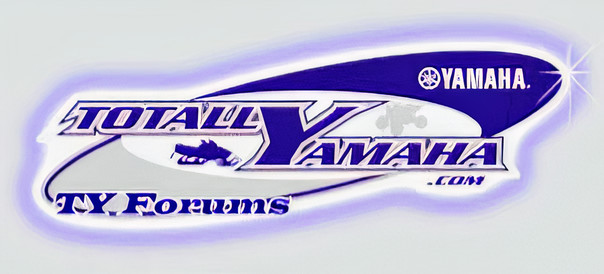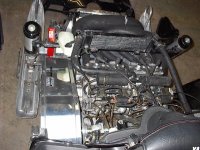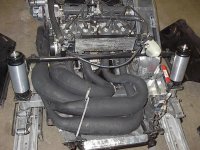Sleigher said:Touchy subjuct on here :P
snip
I did have an old Polaris Indy 500 but it squirted oil into the crank case the same as the SRX. The indy, however, did not have case reed valve it was or is a blow through design. The fuji motors wre good but maybe not technologically advanced :P
Through reading the thread I'm a little confused is all.
Your SRX is different then your Indy was in how it delivers injection oil.
The piston port 500 you had injected oil through a seperate nozzle after the carb and mixed with the incoming air/fuel charge. Your SRX delivers oil to the fuel pump and the oil/fuel mix is delivered to the carb and drawn through the carb as an air/fuel/oil charge.
In other words, your Indy fuel bowls had nothing but fuel where as your SRX has an oil/fuel mix.
no1chevyboy
New member
northern if it was me i would do the switch for a couple of reasons, one no matter what happens to the carbs the motor will get oil, two with oil out of the gas the ethonal has no chance of breaking it down. and once you change over then the work begins rejetting the carbs! you should do wot runs to get the main to where you want it for the temps your going to ride in, then needles then pilot, this is not going to be a fast process it takes time! but i think you will be happy with results! if you do the switch and do nothing to the carbs it will run but it will be rich and not perform well until you run at ? -30 just a guess. its all trial and error the charts for your sled,pipe,ect. are not going to help you there based off mixture not straight fuel.
9801srx
Member
well said! and 100% agreed. the mix ratio in the carbs is alot more stable than is reported in this post. my wifes srx got over 40000km's mine got 17000km's 7000 as a 780 of hard use, lots of racing (right after periods of idleing) with the original injection system and is still on its original crank. also the oil pump has 3 lines comming off of it,2 are tee'ed together and go to the fuel pump the other one goes directly to the engine to feed the gear case, where some leaks past the seals and goes to the center and mag cyl's and the excess oil in the gear case is feed directly to the pto cyl through a hose on the bottom of the crank case. so really these engines kinda have both type systems . opsled from what i've read of your posts your .02 cents is usually worth at least a dollar. lolopsled said:All right. To elaborate on my thoughts.
I think this "belayed" or "delayed" oil injection theory is a Gremlin that doesn't exsist. A creation conjured by people looking to sell parts or by those who just don't see the whole picture.
I've heard the arguments on it and understand the perspective of those who argue them but their rationalization is based on a partial story and one that is unproven.
They argue that the oil/fuel ratio in the carb on this type of injection system changes with rpm and throttle position.
For the argument to be valid it would have to be proved with tests of fuel/oil ratios in the bowl under these different conditions that the ratio changes enough to support their argument. As far as I know this has never been done but is only assumed to be true.
It is assumed to be true because the oil pump delivers more oil at higher rpm and WOT than it does at lower rpm and closed throttle.
The thing is that this is how it MUST!! work to deliver a CONSTANT oil/fuel ratio in the carbs at ALL!! times. People misconcieve this change in oil delivery as a change in ratio. It isn't. It is nothing more than one flow rate having to change to keep up with another.
When you premix fuel in a sled without oil injection the mixture is constant no matter how fast you use it as it has allready been mixed. NO change is nessessary.
In an oil injection system it hasn't been mixed untill it is being used. Different rates of consumtion dictates that both the fuel AND oil systems have the ability to change to keep up with consumption. Change IS nessessary.
Throttle position dictates the rate that fuel is being used. Open throttle fast consumtion of fuel, closed throttle slow consumtion of fuel. In order to keep a constant ratio of fuel/oil mix you need an oil injection system that can match the variability of the fuel consumtion rate. That is why an oil injection system delivers less oil at low rpm/throttle position and more at higher rpm/throttle position.
These oil injection systems do this to keep up with the amount of fuel being used. Not to change the ratio of fuel/oil.
It only stands to reason if you think about it.
Here's what Lucky7 said: (not pickin on ya Lucky just tryin to explain my POV)
"The reason I used these kits was that at idle you are running at almost 80 or 90:1, then you go to full throttle on this lean mixture of oil in your float bowls. After you come down off the pipe you have your bowls full of 40:1 mixture, which isn't bad if you take off still warm, but if you go in for lunch or whatever, you warm up on a fat mixture."
40:1 to 90:1 ???????????
No way!!!!! If that is as consistant as Yamaha can get on an oil injectoin system they have no buisness building them. The ratio of fuel/oil in the carb can't vary that much. If it did there would be engines coming apart all over the place. That hasn't and isn't happening. Yamaha's R&D/engineering is much better than what this ghost problems suggests.
opsled
PS, This is my .02 and as my signature says, I am more than willing to change my perspective if someone can prove my .02 is worthless.
opsled
Active member
no1chevyboy said:ok i have proved this for myself, if you take oil out of the gas you will run rich on fuel in combustion chamber and will need to rejet and adjust all circuits in the carb, (heres what happened to me) i was always running my sled with the oil pump set to the rich side, (the thickness of the line over) well last season i decided to set the oil pump to factory spec,(they always rich on the safe side).well it was runing ok earlier that day, did the adjustment to the oil and kept runing, then noticed if i was leading and could set the pace it was ok but if i had to follow it was hell,just seemed slugish unless i was in the higher rpms. started just doing plug checks again and dam, i went from wet brown to wet black brown, we were runing a loop so as soon as i got back, i pulled the rack and rejetted leaner moved needles leaner and damn right back to what it was before actually alittle better response wise and mileage and have been runing that way ever since, and its been two seasons now. now for the ratio part (opsled) i sure your assuming wrong the on ratio, the pump is variable based on rpm (pump speed) and throttle pos. (valve pos) the whole idea behind the pump is to feed oil to match demand, the old pre mix way you set the ratio and it was the same through out the range so your lower rpms are being drown with oil you only need oil below the combustion chamber, anything that goes into the combustion chamber is robbing performance(loading up fouling plugs). now with the pump you get lets say 100:1 at idle and 50:1 at wot and other ratios in between and an increase in perfomance. now the carb also meters the amount (in a sense)at idle the fuel mixture is being pulled through smaller openings, at wot its being pulled through bigger openings so the amount of mixture fed to the motor changes, its not like a sled is a miser on fuel so as soon as you go from idle to wot all you have to refill with the increased ratio is the bowl and lines from the fuel pump but it never goes without oil. if you go with the direct inject into the bottom the amount of oil needed is less. and fuel jetting is less. go to a boat show and see if there is an ETEC running(some places they can ) there. that motor is direct inject oil and fuel and with there oil can be set to run at 100:1 wot.( just an example) opsled if your belief was correct you would load up at low rpms from excess oil at a constant 50:1. im not slaming you just opening debate.
I understand the oil deluted fuel VS jetting issues you speak of and do not dissagree. Your logic is clear and simple on that point.
However I don't understand your responce to what I said in my post (not sure where your going with it?).
If you are saying that the Yamaha oil pumps vary in output enough to change final fuel/oil mixture from 50:1 to 100:1 (a 100% change????) then I can make sense of your words.
If this is true I would need proof of any claim like that as I don't think it is true that there is that much difference.
If not, I don't know??
opsled
opsled
Active member
9801srx said:opsled from what i've read of your posts your .02 cents is usually worth at least a dollar. lol
So If I figure correctly (please check my math here) you owe me .98 cents.
No checks please..
 lol
lol 
opsled
no1chevyboy
New member
opsled i just through those numbers out there basing it on just about everything runs at 50:1 now. hell in the mid 70s small omc outboards ran 100:1 but now are run at 50:1. just look at how a motor that is premixed runs at idle you can kill misquetoes for miles and you always have to rev them to clear them up. if your way of the same ratio through out the range was correct you would still have to do that. from my experence working on 2strokes i have cleaned alot of pluged exhaust tubes on premix motors that were run at idle to just above, and have never cleaned exhaust on oil injected motors that were run the same. to prove to you with numbers is hard to do, because you would have to find the rpm of the pump at idle, find the position of the valve at idle, and find the flowrate of the oil pump at that point plus the flow rate of the fuel pump with needle valve openings and closings then with those numbers you should be close to ratio for idle, then do all the same at wot to get those numbers and you would get close to that ratio. testing like this is impossible for me! now ill try to find info on the pump, seeing that its made by mikuni (not yamaha) the same pump ive seen on all injection systems that ive worked on it may say in some manual i have?
no1chevyboy
New member
well the only thing i can find is a test for a pump, at idle with pump at wot and it says that as you move the arm the ratio of fuel/oil changes but no ratio numbers, must be top secret, dont want to scare the consumer if the ratios arent what they would expect! lol one thing i did find odd is the pump is the same on three different motors with only an inlet angle change on two but the flow rate is different at same rpm one motor 15.0 cc, the other two 22.0 cc all +- 3.0 cc so mean is 18 cc, this is not a (yamaha test)!!!!!
Last edited:
opsled
Active member
Yup #1Chev, I've looked in the past for the type of info you mentioned myself and could only come up with what you've found minus specs as you say (top secret).
Anywho, I still think this "lean oil" problem that some percieve to be a big deal is way overblown (in Yamaha's at least). I've been running Yammies for years with both direct manifold injection and injection into the fuel pump or fuel line prior to the pump. I have also worked on tons of sled for tons of people and have yet to see an engine issue/failure that I could attribute to design flaws of oil injection systems on Yammies. In any of their forms. I have seen failures in them but they could all be attributed to maintenance or lack there of.
As I've said I think the pros of a Bender direct injection system are arguable but I think the pros of the stock Yamaha system are just as (if not more) valid and without hard evidence from Bender and with the R&D that Yamaha has, including an exellent track record of durability with these systems I will stay with stock and recomend others to do the same.
That said I won't say that the Bender method is bad or will do harm to a sled because I don't think that is true either.
It would be interesting to see an independant test with hard facts and #'s to support these claims one way or the other. But with the 4 stroke's taking over it is really a mute point for the future.
opsled
PS, I recently purchased another 92 Vmax-4 with a complete 90* fire 880 Bender trail kit on it. Pistons, cylinders, crank welding, CDI, quad pipes, carbs, clutching and a direct oil injection kit installed all as one kit from Bender. It's a semi project sled that will be torn down and built back as a hi-perf trail/lake/river runner. It hauls some serious a$$ and Bender really did well with what they built here but the direct oil injection is coming off. The way it's put together and the routing is just to chincy. Lines running everywhere with cheep T's and clamps (can't have it). I also have another 92 with Bender twins and I like them as well so it's not an "I don't like Bender" thing for me. If the fit/finish isn't as good as the OEM stuff it ain't stayin.
Anywho, I still think this "lean oil" problem that some percieve to be a big deal is way overblown (in Yamaha's at least). I've been running Yammies for years with both direct manifold injection and injection into the fuel pump or fuel line prior to the pump. I have also worked on tons of sled for tons of people and have yet to see an engine issue/failure that I could attribute to design flaws of oil injection systems on Yammies. In any of their forms. I have seen failures in them but they could all be attributed to maintenance or lack there of.
As I've said I think the pros of a Bender direct injection system are arguable but I think the pros of the stock Yamaha system are just as (if not more) valid and without hard evidence from Bender and with the R&D that Yamaha has, including an exellent track record of durability with these systems I will stay with stock and recomend others to do the same.
That said I won't say that the Bender method is bad or will do harm to a sled because I don't think that is true either.
It would be interesting to see an independant test with hard facts and #'s to support these claims one way or the other. But with the 4 stroke's taking over it is really a mute point for the future.
opsled
PS, I recently purchased another 92 Vmax-4 with a complete 90* fire 880 Bender trail kit on it. Pistons, cylinders, crank welding, CDI, quad pipes, carbs, clutching and a direct oil injection kit installed all as one kit from Bender. It's a semi project sled that will be torn down and built back as a hi-perf trail/lake/river runner. It hauls some serious a$$ and Bender really did well with what they built here but the direct oil injection is coming off. The way it's put together and the routing is just to chincy. Lines running everywhere with cheep T's and clamps (can't have it). I also have another 92 with Bender twins and I like them as well so it's not an "I don't like Bender" thing for me. If the fit/finish isn't as good as the OEM stuff it ain't stayin.
Attachments
no1chevyboy
New member
i would agree with you on the lean oil spot thing, alot of that is carb settings. but i still like the idea of pure oil getting to the motor uneffectd by the fuel or carb problems
Vmax540
VIP Member
sideshowBob said:Back in "The Day" I think it helped the 1981 SRXs[I have one that still runs!] and the 1983 + up VMAX540s but since then I would recommend sticking with the factory setup.
X2 on these sleds !





